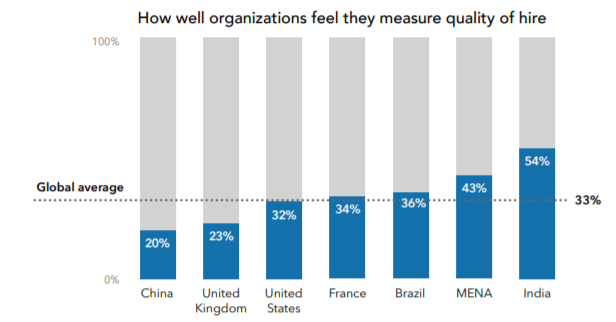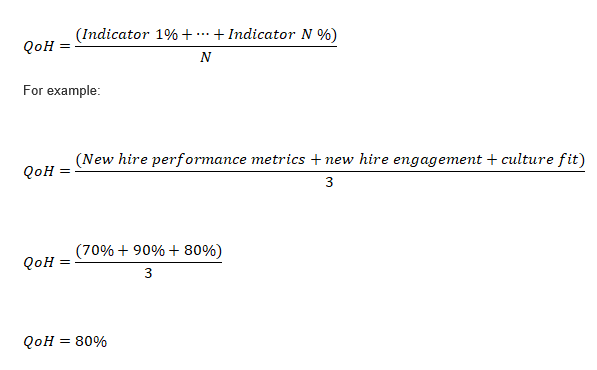Hiring managers have always utilized Quality Of Hire (QOH) as one of their most important metrics when hiring employees. According to LinkedIn, 39% of talent acquisition leaders agree that the quality of hire is the most valuable metric to measure performance. 32% says that employee retention is their top priority over the next 12 months. It is important to know what the metric measures, why is it important, and how can we improve the quality of employees that we hire.
Quality of hire (QoH) is widely defined as the value that a new hire adds to the company. To be precise, the ‘value’ usually means how much an employee contributes to the organization’s long-term success, such as completing necessary tasks and assisting other employees in achieving their goals.
Hiring the right employees into the organization is an important task. A company can only be as good as its employees. As Steve Jobs once said, “The secret of my success is that we have gone to exceptional lengths to hire the best people in the world”. It is indisputable that a good employee will always meet the expectations of the company, if not more, to help the organization to achieve its goals as a whole. Good employees are also individuals who create a positive environment. According to the Harvard Business Review, a positive environment will lead to dramatic benefits for employers, employees, and the bottom line. In contrast, hiring a bad employee will not only not produce results as required or expected, but it will also drag the team motivation and spirit in completing their tasks. Therefore, quality employees will help your company to run and grow.

The consequences of having a bad hire can be expensive. One Fast Company stated that 41% of those surveyed reported that one bad hire in the last year costed them at least $25,000, which is around half of the average salary. The US Department of Labor says the cost of a bad hire can reach up to 30% of the employee’s first-year earnings, while CareerBuilder claims 74% of companies who made a poor hire lost an average of $14,900 per bad hire. Furthermore, it is also costly and time-consuming to fire an employee as hiring managers often have to find replacements and train them all over again. This hiring cost is approximated at more than $4000 per employee, excluding headhunting costs if the organization uses a recruitment company. By estimating the time to fill the role of 2 months, it means that the company will lose the productivity of one-sixth of a year. As discussed previously, a bad hire will also degrade the team spirit, which indirectly costs the employer. However, if background screening is done thoroughly before hiring, the consequences of a bad hire can be avoided altogether. On average, it only costs $150 to screen one employee. Thus, companies should avoid hiring bad employees and make sure they assess the QoH of prospective employees beforehand.
Despite being the most notable metric in hiring practices, leaders still lack confidence in measuring QoH. In the same survey from LinkedIn, talent leaders are not convinced that they are measuring QoH effectively. Only 33% of respondents feel that their methodologies are strong. Several challenges may be present that increases the difficulty in measuring QoH. One of the biggest complaints is that indicators can be very subjective sometimes. It is not possible to give a fixed numeric value on metrics like employee engagement and cultural fit as different employers will provide different scores to the same employee. Therefore, there are a lot of opportunities to improve the calculation of QoH.

The best way to measure QoH is by using quantifiable recruitment metrics that indicate quality. We call these metrics ‘indicators’. According to the report, the 3 most common classic indicators are new hire performance, turnover and retention, and hiring manager satisfaction ratings.
1. New hire performance metrics were used by 51% of companies. As the most used metric in hiring, performance metrics include all measurements relating to the Key Performance Indicators (KPIs).
2. 48% of companies use turnover and retention metrics. This shows whether new hires are good fits in the company. However, this is a risky metric since other factors such as an ineffective onboarding process and management practices might cause attrition.
3. 41% of companies use hiring manager satisfaction ratings. This indicates the satisfaction of the hiring managers towards the quality of their company’s hiring process and their future hires.
We can calculate QoH by using these indicators, including employee value survey that is done by their direct superior, colleagues and subordinates. With the chosen metrics, we can calculate the QoH for a new hire using the weighted average formula:

Other than the QoH, there is also a QoH index. This index shows the overall quality of hires within the company compared to the previous year. For example, if the QoH index rises, then it shows that the employee value of this year increases compared to last year and vice versa.
Retention rate can be measured on its own or calculated using the formula:
Retention rate (%) = 100 – Retention Rate
QoH can be calculated using multiple fixed indicators that suit the company. Each company may have their unique sets of indicators to measure its QoH as the employee attribution, employee productivity, and employee evaluation may differ from one another. QoH shows the progress of QoH of the company to evaluate whether it is increasing, decreasing, or remain the same.
Using QoH to measure a prospective employee has several limitations and might provide unintended results if adopted inaccurately. As discussed earlier, leaders are still not confident in measuring QoH because some of the indicators are not quantifiable. The company may choose not to hire a good employee, and this restricts the growth of the company. In the worst-case scenario, the company might damage its image when many talents are rejected. As a result, future good candidates will not apply to the company as they will have the impression that the company does not appreciate people who are good at their job. At the same time, this will cost a lot to the organization since hiring managers have developed a QoH system to hire, but is ineffective and useless. It will deem their time and money to research the data of employees to calculate QoH useless. Nevertheless, background companies, such as Avvanz, will be able to help organizations to gather accurate data.
Lastly, let’s talk about how to improve our QoH. There are a few steps to be taken to improve the quality of new hires and employee valuation. The first step in improving QoH is — talent acquisition leaders have to define the metrics in the formula. This is rather obvious as we need indicators to measure the QoH as shown in the formula above.
The next step is to collect the right data. During this phase, it is crucial for hiring managers to have the resources to both collect and access pre-hire and post-hire data. Pre-hire data includes interviews, psychometric tests, academic grades, background checks and career portfolio. Post-hire data includes employee value survey, employer satisfaction, and objective data like the number of promotions, sales quota met, and the number of productive days.
Moving on, we have to streamline recruiters’ workload to collect the right data. The disorganized recruiting workflow will often burden hiring managers with additional unnecessary challenges as they will have to take 30% longer to review before placing them in their company. Simplifying their workloads by streamlining and coming up with a standard operating procedure can reduce flow time to fill up positions by 70%.
The last step is to align all hiring managers. Without hiring managers coordinating with each other, it will make the hiring process inefficient even if an SOP is already in place. Measures can be taken to align all managers when hiring new employees. During meetings, group leaders can consistently define QoH. Interviewers can use interview scorecards to take down all necessary information. As a result, these measures can be taken to ensure that the quality of new hires is at its fittest shape.
To summarize, QoH is an important metric when hiring prospective employees, and to ensure the alignment of employee value with the company. Hiring managers can measure the quality of new hires by using a different set of customized metrics that suits the company’s needs. Furthermore, QoH can be measured using the weighted average of the formula, giving more weight to the indicator that the company thinks it is more important. To obtain the data of the indicators related to the employees, hiring managers could partner with companies like Avvanz to check for pre-hire data and in some instances, even post-hire data. Lastly, companies must take steps to guarantee the quality of QoH.
This article is researched and authored by Keigen Tan, a Business Undergraduate with Nanyang Technological University.
References:
https://ideal.com/quality-of-hire/
https://resources.workable.com/tutorial/quality-of-hire
https://www.checkster.com/blog/why-quality-of-hire-is-hrs-most-important-metric



